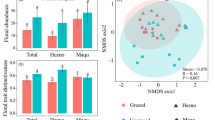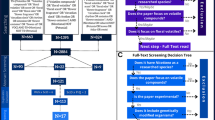Abstract
Mutualisms are interactions from which both partners benefit but may collapse if mutualists’ costs and benefits are not aligned. Host sanctions are one mechanism whereby hosts selectively allocate resources to the more cooperative partners and thereby reduce the fitness of overexploiters; however, many mutualisms lack apparent means of host sanctions. In mutualisms between plants and pollinating seed parasites, such as those between leafflowers and leafflower moths, pollinators consume subsets of the seeds as larval food in return for their pollination service. Plants may select against overexploiters by selectively aborting flowers with a heavy egg load, but in many leafflower species, seeds are fully eaten in some fruits, suggesting that such a mechanism is not present in all species. Instead, the fruits of Breynia vitis-idaea have stalk-like structures (gynophore) through which early-instar moth larvae must bore to reach seeds. Examination of moth mortality in fruits with different gynophore lengths suggested that fruits with longer gynophore had higher moth mortality and, therefore, less seed damage. Most moth mortality occurred at the egg stage or as early larval instar before moths reached the seeds, consistent with the view that gynophore functions to prevent moth access to seeds. Gynophore length was unaffected by plant size, extent of moth oviposition, or geography; thus, it is most likely genetically controlled. Because gynophores do not elongate in related species whose pollinators oviposit directly into the ovary, the gynophore in B. vitis-idaea may have evolved as a defense to limit the cost of the mutualism.






Similar content being viewed by others
References
Addicott JF, Bao T (1999) Limiting the costs of mutualism: multiple modes of interaction between yuccas and yucca moths. Proc R Soc B Biol Sci 266:197–202. doi:10.1098/rspb.1999.0622
Althoff DM, Segraves KA, Pellmyr O (2005) Community context of an obligate mutualism: pollinator and florivore effects on Yucca filamentosa. Ecology 86:905–913. doi:10.1890/04-1454
Althoff DM, Xiao W, Sumoski S, Segraves KA (2013) Florivore impacts on plant reproductive success and pollinator mortality in an obligate pollination mutualism. Oecologia 173:1345–1354. doi:10.1007/s00442-013-2694-8
Axelrod R, Hamilton WD (1981) The evolution of cooperation. Science 211:1390–1396. doi:10.1126/science.7466396
Bao T, Addicott JF (1998) Cheating in mutualism: defection of Yucca baccata against its yucca moths. Ecol Lett 1:155–159. doi:10.1046/j.1461-0248.1998.00032.x
Bull JJ, Rice WR (1991) Distinguishing mechanisms for the evolution of co-operation. J Theor Biol 149:63–74. doi:10.1016/S0022-5193(05)80072-4
Crabb BA, Pellmyr O (2006) Impact of the third trophic level in an obligate mutualism: do yucca plants benefit from parasitoids of yucca moths? Int J Plant Sci 167:119–124. doi:10.1086/497844
Dunn DW, Segar ST, Ridley J, Chan R, Crozier RH, Yu DW, Cook JM (2008a) A role for parasites in stabilising the fig-pollinator mutualism. PLoS Biol 6:0490–0496. doi:10.1371/journal.pbio.0060059
Dunn DW, Yu DW, Ridley J, Cook JM (2008b) Longevity, early emergence and body size in a pollinating fig wasp—implications for stability in a fig-pollinator mutualism. J Anim Ecol 77:927–935. doi:10.1111/j.1365-2656.2008.01416.x
Frederickson ME (2013) Rethinking mutualism stability: cheaters and the evolution of sanctions. Q Rev Biol 88:269–295. doi:10.1086/673757
Goto R, Okamoto T, Toby Kiers E, Kawakita A, Kato M (2010) Selective flower abortion maintains moth cooperation in a newly discovered pollination mutualism. Ecol Lett 13:321–329. doi:10.1111/j.1461-0248.2009.01425.x
Govaerts R, Frodin DG, Radcliffe-Smith A, Carter S (2000) World hecklist and bibliography of Euphorbiaceae (with Pandaceae). Royal Botanic Gardens, Kew
Herre EA, Jandér KC, Machado CA (2008) Evolutionary ecology of figs and their associates: recent progress and outstanding puzzles. Annu Rev Ecol Evol Syst 39:439–458. doi:10.1146/annurev.ecolsys.37.091305.110232
Ibanez S, Gallet C, Dommanget F, Després L (2009) Plant chemical defence: a partner control mechanism stabilising plant–seed-eating pollinator mutualisms. BMC Evol Biol 9:261. doi:10.1186/1471-2148-9-261
Jandér KC, Herre EA (2010) Host sanctions and pollinator cheating in the fig tree-fig wasp mutualism. Proc R Soc B Biol Sci 277:1481–1488. doi:10.1098/rspb.2009.2157
Jandér KC, Herre EA (2016) Host sanctions in Panamanian Ficus are likely based on selective resource allocation. Am J Bot 103:1–10. doi:10.3732/ajb.1600082
Jandér KC, Herre EA, Simms EL (2012) Precision of host sanctions in the fig tree-fig wasp mutualism: consequences for uncooperative symbionts. Ecol Lett 15, pp. 1362–1369, doi:10.1111/j.1461-0248.2012.01857.x
Kato M, Takimura A, Kawakita A (2003) An obligate pollination mutualism and reciprocal diversification in the tree genus Glochidion (Euphorbiaceae). Proc Natl Acad Sci USA 100:5264–5267. doi:10.1073/pnas.0837153100
Kawakita A (2010) Evolution of obligate pollination mutualism in the tribe Phyllantheae (Phyllanthaceae). Plant Species Biol 25:3–19. doi:10.1111/j.1442-1984.2009.00266.x
Kawakita A, Kato M (2004) Obligate pollination mutualism in Breynia (Phyllanthaceae): further documentation of pollination mutualism involving Epicephala moths (Gracillariidae). Am J Bot 91:1319–1325. doi:10.3732/ajb.91.9.1319
Kawakita A, Kato M (2009) Repeated independent evolution of obligate pollination mutualism in the Phyllantheae-Epicephala association. Proc R Soc B Biol Sci 276:417–426. doi:10.1098/rspb.2008.1226
Kawakita A, Kato M (2016) Revision of the Japanese species of Epicephala Meyrick with descriptions of seven new species (Lepidoptera, Gracillariidae). Zookeys 568:87–118. doi:10.3897/zookeys.568.6721
Kawakita A, Mochizuki K, Kato M (2015) Reversal of mutualism in a leafflower-leafflower moth association: the possible driving role of a third-party partner. Biol J Linn Soc 116:507–518. doi:10.1111/bij.12633
Kiers ET, Rousseau RA, West SA, Denison RF (2003) Host sanctions and the legume–rhizobium mutualism. Nature 425:78–81. doi:10.1038/nature01931
Kiers ET, Duhamel M, Beesetty Y, Mensah JA, Franken O, Verbruggen E, Fellbaum CR, Kowalchuk GA, Hart MM, Bago A, Palmer TM, West SA, Vandenkoornhuyse P, Jansa J, Bucking H (2011) Reciprocal rewards stabilize cooperation in the mycorrhizal symbiosis. Science 333:880–882. doi:10.1126/science.1208473
Labouche A-M, Bernasconi G (2013) Cost limitation through constrained oviposition site in a plant-pollinator/seed predator mutualism. Funct Ecol 27:509–521. doi:10.1111/1365-2435.12062
Marr DL, Pellmyr O (2003) Effect of pollinator-inflicted ovule damage on floral abscission in the yucca–yucca moth mutualism: the role of mechanical and chemical factors. Oecologia 136:236–243. doi:10.1007/s00442-003-1279-3
Oliver TH, Leather SR, Cook JM (2009) Tolerance traits and the stability of mutualism. Oikos 118:346–352. doi:10.1111/j.1600-0706.2008.17045.x
Pellmyr O, Huth CJ (1994) Evolutionary stability of mutualism between yuccas and yucca moths. Nature 372:257–260. doi:10.1038/372257a0
Pellmyr O, Leebens-Mack J (2000) Reversal of mutualism as a mechanism for adaptive radiation in yucca moths. Am Nat 156:S62–S76. doi:10.1086/303416
R Development Core Team (2016) R: a language and environment for statistical computing. R Foundation for Statistical Computing, Vienna. ISBN 3-900051-07-0. http://www.R-project.org
Richter KS, Weis AE (1995) Differential abortion in the yucca. Nature 376:557–558
Segraves KA (2003) Understanding stability in mutualisms: can extrinsic factors balance the yucca–yucca moth interaction? Ecology 84:2943–2951. doi:10.1890/02-0619
Segraves KA (2008) Florivores limit cost of mutualism in the yucca–yucca moth association. Ecology 89:3215–3221. doi:10.1890/07-1993.1
Shapiro J, Addicott JF (2004) Re-evaluating the role of selective abscission in moth/yucca mutualisms. Oikos 105:449–460. doi:10.1111/j.0030-1299.2004.12681.x
Wang R-W, Dunn DW, Sun BF (2014) Discriminative host sanctions in a fig–wasp mutualism. Ecology 95:1384–1393. doi:10.1890/13-0749.1
West SA, Herre EA (1994) The ecology of the New World fig-parasitizing wasps Idarnes and implications for the evolution of the fig-pollinator mutualism. Proc R Soc Lond Ser B 258:67. doi:10.1098/rspb.1994.0143
Zhang J, Hu B, Wang S, Li H (2012a) Six new species of Epicephala Meyrick, 1880 (Lepidoptera: Gracillariidae) associated with Phyllanthaceae plants. Zootaxa 54:43–54. doi:10.5281/zenodo.280846
Zhang J, Wang S, Li H, Hu B, Yang X, Wang Z (2012b) Diffuse coevolution between two Epicephala species (Gracillariidae) and two Breynia species (Phyllanthaceae). PLoS One 7:e41657. doi:10.1371/journal.pone.0041657
Zhang J, Yin Y, Wang Z, Zhang Z, Hu B, Shi F, Li H (2016) Mechanisms of population regulation in the mutualism between Breynia vitis-idaea (Euphorbiaceae) and Epicephala vitisidaea (Lepidoptera, Gracillariidae). Acta Entomol Sin 59:239–246. doi:10.16380/j.kcxb.2016.02.014
Acknowledgements
We thank K. Mochizuki and Y. Satani for assistance in the field; Amami Wildlife Center for logistic support during fieldwork; T. Haraguchi and A. Murakami for help with statistical analysis; Y. Kanzaki for help with figure preparations. We also thank two anonymous reviewers for their critical and constructive comments that improved the manuscript. This work was supported by a Japan Society for the Promotion of Science grant to A.K. (no. 24770018).
Author information
Authors and Affiliations
Contributions
SF and AK initiated the study. SF performed the experiments and analyzed the data. SF and AK wrote the manuscript.
Corresponding author
Ethics declarations
Conflict of interest
There is no conflict of interest associated with this study.
Additional information
Communicated by Richard Karban.
Rights and permissions
About this article
Cite this article
Furukawa, S., Kawakita, A. Limiting the cost of mutualism: the defensive role of elongated gynophore in the leafflower–moth mutualism. Oecologia 184, 835–846 (2017). https://doi.org/10.1007/s00442-017-3910-8
Received:
Accepted:
Published:
Issue Date:
DOI: https://doi.org/10.1007/s00442-017-3910-8




